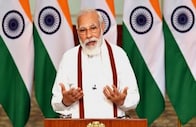An exclusive interview with the award-winning Australian food historian and writer on her journey of exploring India through her changing food for her latest book.
With the advent of social media and delivery apps, food has become more accessible than it ever was in human history. There is a mind-boggling spread available both online and offline, and greater food aspirations. Add to it the rapid rise in average income and consumer culture, and the result is: young India is eating out and ordering in more than ever before.
In her new book Eating the Present, Tasting the Future published earlier this month, Australian food historian and writer Charmaine O'Brien delves deep into India’s fast-changing food preferences and the many factors that are behind this disruption. Armed with rich research, extensive conversations with industry experts, food professionals, and domestic cooks, her solid academic standing, and a 25-year-long relationship with India’s kaleidoscopic culinary traditions, O'Brien attempts to navigate our country’s vast and diverse foodscape, its living heritage, as she calls it, through her latest offering.
Part memoir, part historical, socio-cultural guide, Eating the Present, Tasting the Future is her third book after Flavours of Delhi (2003) and The Penguin Food Guide to India (2013). In this exclusive interview,, she discusses in great detail the book, her fascination with Indian food, how television/OTT platforms and food apps have drastically changed the way Indians perceive and consume food, the emergence of café culture, the myth of reprocessed, attractively packaged “healthy foods”, her enduring love affair with India, and more.
Q. What got you interested in Indian regional food?
A. There is a long, multi-faceted story about this in the book. But one of the most significant elements was that the first time I came to India, I thought Indian food was what you got on an Indian restaurant menu in Australia, and by association, that all Indians were the same. When I discovered this was very far from the reality and that Indians were very different people who spoke different languages, lived in many different cultures, and ate a huge diversity of food that was influenced by all of the above as well as its history, geography, and climate, I was hooked. I wanted to learn all about India and I decided I was going to do it through her food. That was in 1995; I am still learning and it is going to be a lifetime’s work.
Q. Any interesting discoveries that you stumbled upon while researching for this book?
A. A visit to a prawn-processing factory in Visakhapatnam where huge quantities of locally-produced prawns are processed for the US market. India, particularly Andhra Pradesh, has become one of the biggest producers of aquaculture prawns/shrimp in the world and this brings in huge overseas revenue. In the early stages of the pandemic, this industry was severely disrupted resulting in the loss of this revenue, so the government declared it an essential industry to get the export dollars flowing back into India.
Q. As an outsider, were you concerned that despite being well-researched and documented, the book may not be as rooted as it might have been had an Indian written it?
A. With respect to being an ‘outsider’ — I am not Indian — it was a definite concern for me that I might not fully decipher, or potentially, misinterpret the factors, especially social and cultural ones, driving the changes that I have observed in India’s food over the past 25 years. I clearly state my awareness of this in the book’s introduction. It is one of the main reasons I spoke to a wide range of Indians who are involved with food in a professional capacity along with everyday consumers. I have also included popular and scholarly research and writings by Indians related to food and contemporary India. Therefore, this book is not just my opinion, although in some cases it is; it is informed by several Indians as well.
Being an outsider can also offer an advantage. As I am not immersed in the flux of life here all the time, I often notice everyday markers of change that might otherwise go unremarked, and I ask questions about what I observe, so I keep learning about India. Promoting the book here has fostered many new conversations with Indians about food and drink and I very often learn something new from these.
India is a vast and deeply complex country with the world’s most diverse regional cuisines. There is also a multitude of different understandings, experiences, philosophies, affordabilities, and accessibilities around food. So many different perspectives, angles, and knowledge systems that other works on what is happening with food in India written by Indians will surely emerge.
If an Indian had written this book, it would of course have been different. But since this book is my creative work, therefore it is idiosyncratic to me. The book concept was my idea and I brought what I had to offer to its creation: my memories and experiences being a curious and avid student of India who decided to learn about her through her food; my general knowledge of food history and the universal factors that influence societal change in food systems and what, how and where people eat; and the perspective my psychology, thinking, and education affords me in exploring more recent changes in India’s food, including how people’s thinking about food is being influenced to encourage them to take up new consumer behaviors and buy new and more food products.
Q. Was there a conscious thought to ensure that the book didn’t read too academic or scholarly?
A. Oh yes, a very conscious effort. I have completed a PhD and published other academic work and I do bring a scholarly sensibility to my research. But when it comes to creating a narrative for a broader audience, I become a writer who wants to offer readers a rewarding reading experience along with accessible informative content. Contemporary writers operate in the age of the ever-diminishing attention span making it even more imperative to create engaging work. One method I use to achieve this is to read my work out aloud to myself. It helps me build rhythm in my work.
Q. Which Indian dishes/preparations do you find the most fascinating?
A. My previous book, The Penguin Food Guide to India, documents the food of every state of India so there are very many dishes and preparation methods listed in there that I find fascinating…it would be a long list and most would be traditional rather than contemporary. But one dish that has truly stood out is seekh kababs prepared in a home in Delhi. The meat for these was ground to a silky paste on a sil-bat before the other ingredients were added and blended. The resulting kebabs melted in my mouth and nearly 20 years later, I have still not forgotten the taste. No other kebab could ever compare. What I find most fascinating is the painstaking effort India’s domestic cooks, almost always women, take over food preparation.
Q. How do you think the recent rise of tech and the internet in the food industry has influenced the Indian consumer’s perception and eating habits?
A. One chapter in the book is entirely about the rise of food apps and another about the impact of television/OTT platforms and social media on India’s eating habits. These technologies have had a significant impact. Seeing what other people eat around the world through visual mediums has increased the aspirations of Indians to try these foods and businesses have grown up to meet this demand, for example, the boom in cake/bake/chocolate/western-style sweet-treats cafes.
Food apps have furthermore enabled urban Indians to access any sort of food anytime they want without any effort beyond a few taps. Whether this is a good thing or not is debatable. The international investors who funded the process of establishing this habit among Indians are betting on the former.
Q. A global food trend that you think has substantially impacted India’s food choices and preferences?
A. Seeking ‘wellness’ and believing that we can consume our way to health, thinking that one’s health is entirely an individual choice has become pervasive in India. This is impacting what many people are choosing to buy, eat, and drink. The popularity of foods labeled gluten-free, vegan, superfoods, keto, organic, and plant-based are indicators of this. Interestingly, many of these labeled foods have been eaten by Indians for a very long time but now they have been ‘reprocessed’ with these labels and attractive packaging, making people pay more for them.
Q. What is your expectation from this book?
A. I have attempted to place India’s changing foodscape into a global context alongside describing its uniqueness and current and emerging challenges. My hope is that people be further inspired to value the vast storehouse of foodways and food traditions in India and be alert to the more subtle ways they are being influenced to consume more and different foods and the potential systemic consequences of this. I imagine this book as a love letter, albeit a very long one, to India, not one borne of a new passionate affair, but rather a long-established relationship (of 25 years or so) in which one appreciates the good qualities of the loved one and has the confidence of knowing the relationship can withstand challenges.
First Published: Apr 25, 2023 2:28 PM IST
Check out our in-depth Market Coverage, Business News & get real-time Stock Market Updates on CNBC-TV18. Also, Watch our channels CNBC-TV18, CNBC Awaaz and CNBC Bajar Live on-the-go!







